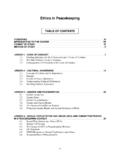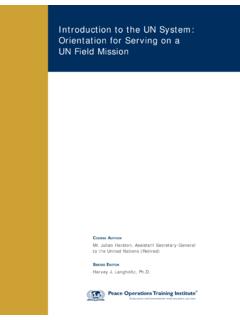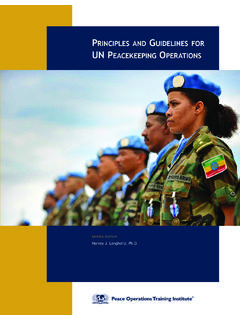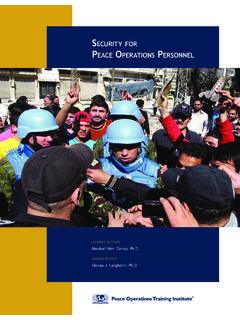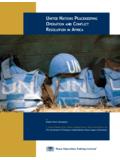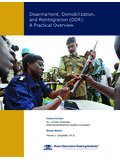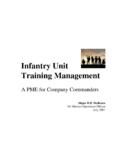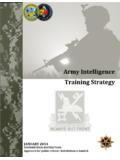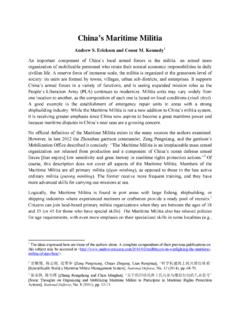Transcription of Civil-Military Coordination in Peace Operations
1 Peace Operations training Institute Study Peace and humanitarian relief any place, any timeCourse AuthorsChristopher Holshek, Colonel (retired) US Army civil AffairsCedric de Coning, ACCORD/NUPI series editorHarvey J. Langholtz, Coordination in Peace OperationsPeace Operations training Institute Study Peace and humanitarian relief any place, any timeCourse AuthorsChristopher Holshek, Colonel (retired) US Army civil AffairsCedric de Coning, ACCORD/NUPI series editorHarvey J. Langholtz, Coordination in Peace OperationsCover Photo: UN Photo #171677 by Stuart Price. Brigadier General Bala Keita (fifth from left), military commander of the Western Sector of the African Union/United Nations Hybrid operation in Darfur (UNAMID), talks with the Arab nomads, following a consultation meeting. 16 March 2008. 2017 Peace Operations training Institute.
2 All rights Operations training Institute 1309 Jamestown Road, Suite 202 Williamsburg, VA 23185 USA edition: 2008 Second edition: 2012 The material contained herein does not necessarily reflect the views of the Peace Operations training Institute (POTI), the Course Author(s), or any United Nations organs or affiliated organizations. The Peace Operations training Institute is an international not-for-profit NGO registered as a 501(c)(3) with the Internal Revenue Service of the United States of America. The Peace Operations training Institute is a separate legal entity from the United Nations. Although every effort has been made to verify the contents of this course, the Peace Operations training Institute and the Course Author(s) disclaim any and all responsibility for facts and opinions contained in the text, which have been assimilated largely from open media and other independent sources.
3 This course was written to be a pedagogical and teaching document, consistent with existing UN policy and doctrine, but this course does not establish or promulgate doctrine. Only officially vetted and approved UN documents may establish or promulgate UN policy or doctrine. Information with diametrically opposing views is sometimes provided on given topics, in order to stimulate scholarly interest, and is in keeping with the norms of pure and free academic pursuit. Versions of this course offered in other languages may differ slightly from the primary English master copy. Translators make every effort to retain the integrity of the Operations training INSTITUTET able of ContentsCivil- military Coordination in Peace OperationsForeword ixMethod of Study xiLesson 1 What Is Civil-Military Coordination ? 12 Introduction 13 Section The Nature of Civil-Military Coordination 14 Section Civil-Military Coordination and the use of force 18 Section Comparative Approaches to Civil-Military Coordination 24 Lesson 2 Civil-Military Coordination in the Full Spectrum of Peace Operations 40 Section The Evolution of Complex, Full Spectrum Peace Operations 44 Section Civil-Military Coordination in the Full Spectrum of Peace Operations 50 Section Integrated Peace Operations : civil and military Partners 54 Section Snapshot of a Peacebuilding Mission.
4 UNMIL 65 Section The AMISOM Mandate 68 Lesson 3 military Support to Humanitarian Assistance and Disaster Relief 78 Civil-Military Coordination IN Peace OPERATIONSPEACE Operations training INSTITUTEvISection UN Humanitarian Civil-Military Coordination 80 Section military Support Roles 90 Section Practical Discussion The Haiti Earthquake of 2010 92 Lesson 4 military Support to Peacebuilding 108 Section The Peacekeeping/Peacebuilding Nexus 110 Section Peacebuilding Frameworks 114 Section Peacebuilding Actors 119 Section Civilianizing and Localizing 123 Section Peacebuilding and Conflict Management 128 Lesson 5 UN Mission Integration and Coordination 136 Section Coordination in a Peace Operations Context 138 Section UN Mission Coordination 142 Section UN Mission Civil-Military Coordination Structures 147 Section Integrated Assessment and Planning 149 Section UN-CIMIC Structures and Capabilities 151 Lesson 6 Civil-Military Liaison and Information Sharing 160 Section What is Civil-Military Liaison?
5 162 Section Civil-Military Assessment and Intelligence 167 Section Civil-Military Information Sharing and Information Management 169 Lesson 7 civil Assistance 178 Section Mission Support and Community Support 180 Section Protection of Civilians 190 Section Support to Disarmament, Demobilization, and Reintegration (DDR) and Security and Defence Sector Reform (SSR/DSR) 195 Civil-Military Coordination IN Peace OPERATIONSPEACE Operations training INSTITUTEvIISection military Support to Development 202 Lesson 8 Civil-Military Planning and Project Management 212 Section UN-CIMIC Project Management 214 Section Quick Impact Projects 221 Section Civil-Military Monitoring and Evaluation 224 Lesson 9 Civil-Military Communication 234 Section Civil-Military Coordination and Public Information 236 Section Cross-Cultural Communication 241 Section Working with Interpreters 245 Section Negotiations and Conflict Mitigation 248 Civil-Military Coordination IN Peace OPERATIONSPEACE Operations training INSTITUTEvIIIA ppendicesAppendix A: Glossary and list of Acronyms 260 Appendix B: Comparative UN Civil-Military Officer Terms of Reference 279 Appendix C.
6 Sample Civil-Military Project Management Guidelines & Project Management Outline 285 Appendix D: Sample UN Mission UN-CIMIC training and Education Plan 290 Appendix E: Sample UN-CIMIC Directive 291 Appendix F: Sample UN-CIMIC Operations Briefing 292 Appendix G: Survey of Further Civil-Military training & Education Resources 293 About the Author: Col. Christopher Holshek (retired) 295 About the Author: Dr. Cedric de Coning 296 Instructions for the End-of-Course Examination 297 Civil-Military Coordination IN Peace OPERATIONSPEACE Operations training INSTITUTEIxThis course provides an overview of the theory and practice of Civil-Military Coordination within the full spectrum of Peace Operations proffered in the 2015 Report of the High-Level Independent Panel on United Nations Peace Operations (HIPPO Report) and explained in United Nations Peacekeeping Operations : Principles and Guidelines (2008) and UN Security Council Resolution 2086 on multidimensional peacekeeping.
7 As such, it reviews the dialogue and interface among the military , civilian, and police components of a Peace operation with respect to political, security, humanitarian, developmental, and other dimensions of the same operation to attain larger, more strategic political goals. This may be in the conduct of conflict prevention, peacemaking, Peace enforcement, peacekeeping, peacebuilding, and humanitarian assistance, or under stabilization or conflict management misconstrued as a tactical activity in the pursuit of public relations agendas, Civil-Military Coordination is an inherently strategic endeavour that is essentially about managing interactions among disparate players involved in or peripheral to the Peace process. It is also about the management of transition from conflict to Peace and from military to civilian dominance of that process. Civil-Military Coordination is essential to any complex Peace operation because it is central to mission Coordination and the achievement of a system-wide impact on the Civil-Military Coordination (UN-CIMIC) officers are military officers responsible for the military part of interactions among civilian, police, and military components of an integrated UN field mission in a Peace Operations environment.
8 They must work effectively with UN Humanitarian Civil-Military Coordination (UN-CMCoord), civil Affairs, and Political Affairs officers, as well as many others working in the Civil-Military Coordination context. They also need to understand the roles and functions of development and peacebuilding actors, including UN Police, in order to facilitate and coordinate support from the peacekeeping force to others in the mission, non-mission actors, and the local community, as course is designed for multiple audiences. For UN-CIMIC officers, it serves as an introduction to the basics of Civil-Military Coordination within a wider UN Peace Operations context and as a field reference. For UN and non-UN civilian, police, and military personnel, it provides instruction on Civil-Military Coordination in general. This is to facilitate greater interoperability while respecting the integrity and equities among disparate multilateral, regional, national, and local organizations working for a common purpose as part of or in partnership with UN-mandated Operations .
9 This includes in particular primary UN mission partners such as CMCoord, civil Affairs and Political Affairs officers, UN Police, and military Experts on Mission, as well as those involved in security and safety; rule of law; logistics; and other mission, agency, and organizational leadership both theory and practice, this course is laid out in two informal parts. The first part (Lessons 1-4) explains the concepts and principles of Civil-Military Coordination mainly from a wider full-spectrum UN Peace Operations context, with particular attention given to military support to humanitarian assistance and peacebuilding. The second part (Lessons 5-8) goes into the practical application of these strategic ideas at the operational and tactical levels. These lessons pay particular attention to ForewordCIvIL- military Coordination IN Peace OPERATIONSPEACE Operations training INSTITUTE xcivil- military relations and transition management through civil assistance (including the protection of civilians and Coordination with police) and joint analysis, planning, monitoring and evaluation, and project management.
10 The final part (Lesson 9) is a review of Civil-Military Coordination as an exercise in adaptive leadership and course is a natural progression from the original 2008 POTI course, Civil-Military Coordination , as well as the 2012 course titled UN Civil-Military Coordination . This edition is based on best practices obtained from various UN field missions, the Department of Peacekeeping Operations Integrated training Service, the UN Office for the Coordination of Humanitarian Affairs (OCHA), and other sources. It was also developed with knowledge of the Handbook on Human Security: A Civil-Military -Police Curriculum by the international civil Society Consortium and available through the Peace Portal. A course of this nature can never cover all potential variations, especially in a fast-changing and dynamic environment. This course focuses on the broad application of concepts, principles, and policies.
